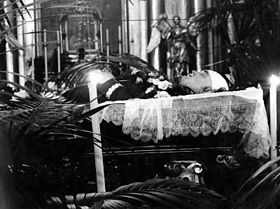Assassination of Bronisław Pieracki
1934 murder in Warsaw, Poland From Wikipedia, the free encyclopedia
1934 murder in Warsaw, Poland From Wikipedia, the free encyclopedia
The assassination of Bronisław Pieracki was a target killing of a Polish politician of the interwar period, Minister of Interior Bronisław Pieracki (1895-1934), by the Organization of Ukrainian Nationalists (OUN).
| Assassination of Bronisław Pieracki | |
|---|---|
| Part of OUN terror operations in Poland | |
 The body of the assassinated minister | |
| Location | Foksal Street in Warsaw |
| Date | 15 June 1934 15:30 |
| Target | Bronisław Pieracki, deputy of Chief of Staff, Poland |
Attack type | Shooting |
| Weapons | 7.65 mm caliber revolver [1] |
| Perpetrators | OUN led by Stepan Bandera |
| Assailants | Hryhorii Matseiko |
| Motive | Political assassination |
The chosen assassin, Hryhorii Matseiko pseudonym "Gonta", was a trusted member of OUN.[2]
The OUN was formed in Poland in 1929 by a number of nationalist organizations. It professed ethno-nationalism, including hostility to Poles, and in its first decade carried out many acts of terrorism, including political assassinations.[3][4]
The assassination plan was decided at an OUN meeting in Berlin. Matseiko was supplied with a makeshift bomb and a 7.65mm caliber pistol from Bandera.[1] In the morning of 15 June 1934 Matseiko (aged 31) appeared at the Foksal Street in Warsaw in front of a social club frequented by Pieracki. He waited there for several hours undetected. The minister arrived in his limousine at 3:30 pm; however, Matseiko's bomb failed. He pulled the gun and shot the minister from behind twice in the back of his head.[2] Matseiko escaped successfully with the help of OUN emissaries as far as Czechoslovakia and then on to Argentina.[5]
Pieracki's state funeral was attended by some 100,000 people. The coffin was sent to Nowy Sącz in a special train and laid in his family tomb.[6]
Despite the assassin dropping a blue and yellow ribbon, a symbol of the OUN terrorist organisation, at the scene of the crime,[7] the Polish authorities professed not to realize that OUN was behind the assassination and blamed the Polish National Radical Camp (ONR) for it. The mistake had terrible consequences for Poland's political life.[5] As a result of this, the Bereza Kartuska prison for dissidents was established.[2]

A year later, it became known that OUN was behind the assassination of Bronisław Pieracki. The trial of OUN leaders before a Warsaw circuit court took place between 18 November 1935 and 13 January 1936. Sixteen OUN members, including Stepan Bandera and Mykola Lebed, were found guilty of organizing the assassination.[6]
After a two-month trial in Warsaw, the court sentenced the guilty as follows:
The court also denied Hnatkivska, Malyutsa, Kachmarsky, Myhal, Chorny, Zarytska and Rak civil rights for 10 years.[citation needed]
The actual assassin, Hryhorii Matseiko, never faced a judge; he died in Buenos Aires in 1966.[5][6]
Seamless Wikipedia browsing. On steroids.
Every time you click a link to Wikipedia, Wiktionary or Wikiquote in your browser's search results, it will show the modern Wikiwand interface.
Wikiwand extension is a five stars, simple, with minimum permission required to keep your browsing private, safe and transparent.